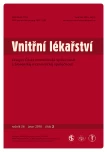Antithrombotic therapy in pregnancy
Authors:
M. Procházka 1; J. Procházková 2; L. Slavík 2
Authors‘ workplace:
Porodnicko‑gynekologická klinika Lékařské fakulty UP a FN Olomouc, přednosta doc. MU Dr. Radovan Pilka, Ph. D., 2Hematoonkologická klinika Lékařské fakulty UP a FN Olomouc, přednosta prof. MU Dr. Karel Indrák, DrSc.
1
Published in:
Vnitř Lék 2010; 56(2): 130-137
Category:
Reviews
Overview
Despite the fact of low prevalence of maternal death, deep venous thrombosis remains one of the most serious complication in pregnancy and puerperium. Virchows triad – vascular stasis, hypercoagulability, and vascular trauma plays the main role in the pathogenesis of deep vein thrombosis in pregnancy. Low molecular weight heparins and unfractionated heparins are the best treatment option. The aim of the treatment is to be effective in extension of thrombus and prevention of the postthrombotic syndrome and pulmonary embolism. Management of pregnant women with increased risk of venous thromboembolism can be stratified by determining whether the prior episode VTE was unprovoked or associated with a transient risk factor and the presence or absence of an inherited thrombophilia.
Key words:
deep vein thrombosis – pulmonary embolism – pregnancy – thrombophilia – heparin
Sources
1. Pettker CM, Lockwood CJ. Pathophysiology and diagnosis of thromboembolic disorders in pregnancy. In: Queenan JT et al (eds). Management of High‑Risk Pregnancy, an evidence based approach. Oxford: Blackwell‑Publishing, 5th ed. 2007: 133– 141.
2. Dahlbäck B. Blood coagulation. Lancet 2000; 355: 1627– 1632.
3. Dahlbäck B. The protein C anticoagulant system: inherited defects as a basis for venous thrombosis. Thromb Res 1995; 77: 1– 43.
4. Dahlbäck B. Resistance to activate protein C, the Arg506 to Gln mutation in the factor V gene, and venous thrombosis. Functional tests and DNA – based assays, pros and cons (see comments). Thromb Haemost 1995; 73: 739– 742.
5. Dizzon- Townson DS, Nelson LM, Jang Het al. The incidence of the factor V Leiden mutation in an obstetric population and its relationship to deep venous thrombosis. Am J Obstet Gynecol 1997; 176: 883– 886.
6. Egeber O. Inherited antithrombin deficiency causing thrombophilia. Thromb Diath Haemorrh 1965; 13: 516– 530.
7. Lockwood CJ. Heritable coagulopathies in pregnancy. Obstet Gynecol Surv 1999; 54: 754– 765.
8. Gumulec J, Radina M, Kučerová M et al. Asociace hyperhocysteinemie, karence vitaminu B12, folátu a poruchy funkce ledvin: vlastní zkušenosti. Laboratorní hematologie, Hradec Králové: HK CREDIT 2000, 68– 69.
9. Hyánek J, Hoffman R. Hyperhomocysteinémie a její diagnostický význam u cévních onemocnění. Praktická flebologie 1997; 2: 61– 71.
10. Penka M, Bulíková A, Žáčková D et al. Clinical Importance of Hyperfibrinogenemia in Hematologic Malignancies. Hematologica. J Hematol, Vol 84, EHA‑ 4 Abstract Book, June 1999, 4th Congress of the EHA, Barcelona, Spain, 186 (PO‑ 0788).
11. Poort SR, Rosendaal FR, Reitsma PH et al. A common genetic variation in the 3- untranslated region of the prothrombin gene is associated with elevated plasma prothrombin levels and an increase in venous thrombosis. Blood 1996; 88: 3698– 3703.
12. Bulíková A, Penka M, Matýšková M et al. Antifosfolipidový syndrom v graviditě. 3. 3. 2000, VI. Pařízkův den, abstrakta, 18– 20.
13. Andělová K, Šůla K, Velebil P. Význam screeningového vyšetření antikardiolipinových protilátek v těhotenství. Čes Gynek 1998; 63: 446– 449.
14. Kvasnička J. Patofyziologie žilní trombózy. Moderní gynekologie a porodnictví 2002; 11: 323– 329.
15. De Caterina R, Libby P. Endothelial Dysfunctions and Vascular Disease. Blackwell Publishing 2007, 3– 25.
16. Hoffbrand AV, Catovsky D, Tuddenham EGD. Postgraduate Hematology. Blackwell Publishing 2005, 787– 792.
17. Kvasnička J. Trombofilie a trombotické stavy v klinické praxi. Praha: Grada Publishing 2003, 40– 65.
18. Assessment of Endothelial Dysfunction: Focus on Atherothrombotic Disease. Pathophysiol Haemost Thromb 2005; 34.
19. Fruhwirt J, Gutchi W, Amann G et al. Ergebnisse der chirurgischen Behandlung der schwangerschaftsassoziirten Beckenvenenthrombose. Z Geburtsh Neonat 1997; 201: 91– 94.
20. Rath W, Heilmann L. Gerinnungsstörungen in Gynäkologie und Geburtshilfe. Georg Thieme Verlag 1999: 132– 143.
21. Ginsberg JS, Hirsch J, Turner DC. Risk to the fetus of anticoagulation therapy during pregnancy. Thromb Haemost 1989; 61: 197– 203.
22. Greer IA. Thrombosis in pregnancy: maternal and fetal issues. Lancet 1999; 353: 1258– 1265.
23. Ludwig HH. Thrombolytic treatment during pregnancy. Thromb Haemost 1981; 46: 438.
24. Procházková J. Diagnostika a léčba žilní trombózy v těhotenství. Medicína po promoci 2008; 9: 35– 37.
Labels
Diabetology Endocrinology Internal medicineArticle was published in
Internal Medicine

2010 Issue 2
Most read in this issue
- Central diabetes insipidus in adult patients – the first sign of Langerhans cell histiocytosis and Erdheim‑Chester disease. Three case studies and literature review
- Risk of long‑term antisecretory treatment with proton pump inhibitors
- A case study of a young male patient with subacute constrictive pericarditis
- Direct renin inhibitor aliskiren in the treatment of cardiovascular and renal diseases
